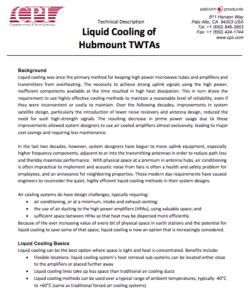Latest News

To read the full article, fill out the download form below.
Liquid cooling was once the primary method for keeping high power microwave tubes and amplifiers and transmitters from overheating. The necessity to achieve strong uplink signals using the high power, inefficient components available at the time resulted in high heat dissipation. This in turn drove the requirement to use highly effective cooling methods to maintain a reasonable level of reliability, even if they were inconvenient or costly to maintain. Over the following decades, improvements in system satellite design, particularly the introduction of lower noise receivers and antenna design, reduced the need for such high-strength signals. The resulting decrease in prime power usage due to these improvements allowed system designers to use air-cooled amplifiers almost exclusively, leading to major cost savings and requiring less maintenance.
In the last two decades, however, system designers have begun to move uplink equipment, especially higher frequency components, adjacent to or into the transmitting antennae in order to reduce path loss and thereby maximize performance. With physical space at a premium in antenna hubs, air conditioning is often impractical to implement and acoustic noise from fans is often a health and safety problem for employees, and an annoyance for neighboring properties. These modern day requirements have caused engineers to…
READ THE FULL ARTICLE
To read the full article please fill out this form:
By submitting this form, you give CPI and Access Intelligence consent to email you about relevant products, services, announcements and offers.
Get the latest Via Satellite news!
Subscribe Now